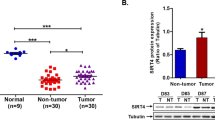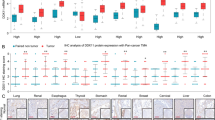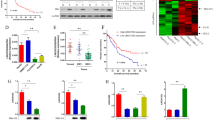Abstract
Hepatocellular carcinoma (HCC) is one of the leading causes of cancer deaths worldwide and is highly correlated with hepatitis virus infection. Our previous report shows that a DEAD box RNA helicase, DDX3, is targeted and regulated by hepatitis C virus (HCV) core protein, which implicates the involvement of DDX3 in HCV-related HCC development. In this study, the potential role of DDX3 in hepatocarcinogenesis is investigated by examining its expression in surgically excised human HCC specimens. Here we report the differential deregulation of DDX3 expression in hepatitis virus-associated HCC. A significant downregulation of DDX3 expression is found in HCCs from hepatitis B virus (HBV)-positive patients, but not from HCV-positive ones, compared to the corresponding nontumor tissues. The expression of DDX3 is differentially regulated by the gender and, moreover, there is a tendency that the downregulation of DDX3 expression in HCCs is more frequent in males than in females. Genetic knockdown of DDX3 with small interfering RNAs (siRNA) in a nontransformed mouse fibroblast cell line, NIH-3T3, results in a premature entry to S phase and an enhancement of cell growth. This enhanced cell cycle progression is linked to the upregulation of cyclin D1 and the downregulation of p21WAF1 in the DDX3 knockdown cells. In addition, constitutive reduction of DDX3 expression increases the resistance of NIH-3T3 cells to serum depletion-induced apoptosis and enhances the ras-induced anchorage-independent growth, indicating the involvement of DDX3 in cell growth control. These findings together with the previous study suggest that the deregulation of DDX3, a DEAD box RNA helicase with cell growth-regulatory functions, is involved in HBV- and HCV-associated pathogenesis.
This is a preview of subscription content, access via your institution
Access options
Subscribe to this journal
Receive 50 print issues and online access
$259.00 per year
only $5.18 per issue
Buy this article
- Purchase on Springer Link
- Instant access to full article PDF
Prices may be subject to local taxes which are calculated during checkout









Similar content being viewed by others
References
Ahn J, Flamm SL . (2004). Dis Monitor 50: 556–573.
Alarcon-Vargas D, Ronai Z . (2002). Cancer Biol Ther 1: 237–242.
Albertson DG, Collins C, McCormick F, Gray JW . (2003). Nat Genet 34: 369–376.
Bréchot C . (2004). Gastroenterology 127: S56–S61.
Bréchot C, Gozuacik D, Murakami Y, Paterlini-Brechot P . (2000). Semin Cancer Biol 10: 211–231.
Brooks CL, Gu W . (2003). Curr Opin Cell Biol 15: 164–171.
Buendia MA . (2000). Semin Cancer Biol 10: 185–200.
Causevic M, Hislop RG, Kernohan NM, Carey FA, Kay RA, Steele RJ et al. (2001). Oncogene 20: 7734–7743.
Chen CJ, You SL, Lin LH, Hsu WL, Yang YW . (2002). Jpn J Clin Oncol 32 (Suppl): S66–S81.
De Petro G, Tavian D, Copeta A, Portolani N, Giulini SM, Barlati S . (1998). Cancer Res 58: 2234–2239.
Deane NG, Parker MA, Aramandla R, Diehl L, Lee WJ, Washington MK et al. (2001). Cancer Res 61: 5389–5395.
El-Serag HB . (2004). Gastroenterology 127: S27–S34.
El-Serag HB, Davila JA, Petersen NJ, McGlynn KA . (2003). Ann Intern Med 139: 817–823.
Endo K, Ueda T, Ohta T, Terada T . (2000). Liver 20: 209–215.
Fu M, Wang C, Li Z, Sakamaki T, Pestell RG . (2004). Endocrinology 145: 5439–5447.
Fukushima K, Ueno Y, Yamagiwa Y, Yamakawa M, Iwasaki T, Ishii M et al. (2001). Hepatol Res 20: 52–67.
Furutani M, Arii S, Tanaka H, Mise M, Niwano M, Harada T et al. (1997). Cancer Lett 111: 191–197.
Godbout R, Packer M, Bie W . (1998). J Biol Chem 273: 21161–21168.
Gregory RI, Shiekhattar R . (2005). Cancer Res 65: 3509–3512.
Hanahan D, Weinberg RA . (2000). Cell 100: 57–70.
Hsu HC, Cheng W, Lai PL . (1997). Cancer Res 57: 5179–5184.
Huang JS, Chao CC, Su TL, Yeh SH, Chen DS, Chen CT et al. (2004). Biochem Biophys Res Commun 315: 950–958.
Hui AM, Kanai Y, Sakamoto M, Tsuda H, Hirohashi S . (1997). Hepatology 25: 575–579.
Hui AM, Shi YZ, Li X, Takayama T, Makuuchi M . (2000). Cancer Lett 154: 93–99.
Huynh H . (2004). Carcinogenesis 25: 1485–1494.
Joo M, Kang YK, Kim MR, Lee HK, Jang JJ . (2001). Liver 21: 89–95.
Jung YJ, Lee KH, Choi DW, Han CJ, Jeong SH, Kim KC et al. (2001). Cancer Lett 168: 57–63.
Kahlina K, Goren I, Pfeilschifter J, Frank S . (2004). J Biol Chem 279: 44872–44882.
Kawate S, Fukusato T, Ohwada S, Watanuki A, Morishita Y . (1999). Oncology 57: 157–163.
Kim YS, Lee SG, Park SH, Song K . (2001). Mol Cells 12: 209–214.
Kobayashi T, Sugawara Y, Shi YZ, Makuuchi M . (2002). Am J Gastroenterol 97: 3166–3171.
Kobayashi Y, Higashi T, Nouso K, Nakatsukasa H, Ishizaki M, Kaneyoshi T et al. (2000). J Hepatol 32: 612–617.
Lahn BT, Page DC . (1997). Science 278: 675–680.
Lee JO, Kwun HJ, Jung JK, Choi KH, Min DS, Jang KL . (2005). Oncogene (doi: 10.1038/sj.onc.1208827).
Liang TJ, Heller T . (2004). Gastroenterology 127: S62–S71.
Linder P, Lasko PF, Ashburner M, Leroy P, Nielsen PJ, Nishi K et al. (1989). Nature 337: 121–122.
Lukas J, Groshen S, Saffari B, Niu N, Reles A, Wen WH et al. (1997). Am J Pathol 150: 167–175.
Lüking A, Stahl U, Schmidt U . (1998). Crit Rev Biochem Mol Biol 33: 259–296.
Macaluso M, Paggi MG, Giordano A . (2003). Oncogene 22: 6472–6478.
Mamiya N, Worman HJ . (1999). J Biol Chem 274: 15751–15756.
Marchetti A, Doglioni C, Barbareschi M, Buttitta F, Pellegrini S, Bertacca G et al. (1996). Oncogene 12: 1319–1324.
Masaki T, Shiratori Y, Rengifo W, Igarashi K, Yamagata M, Kurokohchi K et al. (2003). Hepatology 37: 534–543.
Matsushita K, Kobayashi S, Kato M, Itoh Y, Okuyama K, Sakiyama S et al. (1996). Int J Cancer 69: 259–264.
Murakami Y, Hayashi K, Hirohashi S, Sekiya T . (1991). Cancer Res 51: 5520–5525.
Nagano H, Noguchi T, Inagaki K, Yoon S, Matozaki T, Itoh H et al. (2003). Oncogene 22: 4656–4663.
Nakagawa Y, Morikawa H, Hirata I, Shiozaki M, Matsumoto A, Maemura K et al. (1999). Br J Cancer 80: 914–917.
Nishida N, Fukuda Y, Kokuryu H, Toguchida J, Yandell DW, Ikenega M et al. (1993). Cancer Res 53: 368–372.
Ogata N, Kamimura T, Asakura H . (1991). Hepatology 13: 31–37.
Owsianka AM, Patel AH . (1999). Virology 257: 330–340.
Paik SY, Park YN, Kim H, Park C . (2003). Mod Pathol 16: 86–96.
Pang R, Yuen J, Yuen MF, Lai CL, Lee TK, Man K et al. (2004). Oncogene 23: 4182–4186.
Park SH, Lee SG, Kim Y, Song K . (1998). Cytogenet Cell Genet 81: 178–179.
Parkin DM, Bray F, Ferlay J, Pisani P . (2001a). Int J Cancer 94: 153–156.
Parkin DM, Bray FI, Devesa SS . (2001b). Eur J Cancer 37 (Suppl 8): S4–S66.
Qin LF, Ng IO, Fan ST, Ng M . (1998). Int J Cancer 79: 424–428.
Rashid A, Wang JS, Qian GS, Lu BX, Hamilton SR, Groopman JD . (1999). Br J Cancer 80: 59–66.
Rocak S, Linder P . (2004). Nat Rev Mol Cell Biol 5: 232–241.
Saito I, Miyamura T, Ohbayashi A, Harada H, Katayama T, Kikuchi S et al. (1990). Proc Natl Acad Sci USA 87: 6547–6549.
Sato Y, Itoh F, Hareyama M, Satoh M, Hinoda Y, Seto M et al. (1999). J Gastroenterol 34: 486–493.
Shackelford J, Pagano JS . (2004). Mol Cell Biol 24: 5089–5093.
Shi YZ, Hui AM, Takayama T, Li X, Cui X, Makuuchi M . (2000). Br J Cancer 83: 50–55.
Stevenson RJ, Hamilton SJ, MacCallum DE, Hall PA, Fuller-Pace FV . (1998). J Pathol 184: 351–359.
Suriawinata A, Xu R . (2004). Semin Liver Dis 24: 77–88.
Tanaka S, Toh Y, Adachi E, Matsumata T, Mori R, Sugimachi K . (1993). Cancer Res 53: 2884–2887.
Tannapfel A, Grund D, Katalinic A, Uhlmann D, Kockerling F, Haugwitz U et al. (2000). Int J Cancer 89: 350–355.
Tannapfel A, Wittekind C . (2002). Virchows Arch 440: 345–352.
Taylor-Robinson SD, Foster GR, Arora S, Hargreaves S, Thomas HC . (1997). Lancet 350: 1142–1143.
Thorgeirsson SS, Grisham JW . (2002). Nat Genet 31: 339–346.
Torbenson M, Marinopoulos S, Dang DT, Choti M, Ashfaq R, Maitra A et al. (2002). Hum Pathol 33: 871–876.
Tron VA, Tang L, Yong WP, Trotter MJ . (1996). Am J Pathol 149: 1139–1146.
Ueki T, Fujimoto J, Suzuki T, Yamamoto H, Okamoto E . (1997). Hepatology 25: 862–866.
Wei Y, Van Nhieu JT, Prigent S, Srivatanakul P, Tiollais P, Buendia MA . (2002). Hepatology 36: 692–701.
Xie HL, Su Q, He XS, Liang XQ, Zhou JG, Song Y et al. (2004). World J Gastroenterol 10: 1125–1131.
Yan J, Yu Y, Wang N, Chang Y, Ying H, Liu W et al. (2004). Oncogene 23: 1939–1949.
Yedavalli VS, Neuveut C, Chi YH, Kleiman L, Jeang KT . (2004). Cell 119: 381–392.
You LR, Chen CM, Yeh TS, Tsai TY, Mai RT, Lin CH et al. (1999). J Virol 73: 2841–2853.
Yu MC, Yuan JM . (2004). Gastroenterology 127: S72–S78.
Yuen MF, Wu PC, Lai VC, Lau JY, Lai CL . (2001). Cancer 91: 106–112.
Zhang J, Wang WL, Li Q, Qiao Q . (2004). World J Gastroenterol 10: 830–833.
Zhang XK, Huang DP, Qiu DK, Chiu JF . (1990). Oncogene 5: 909–914.
Zhou Z, Licklider LJ, Gygi SP, Reed R . (2002). Nature 419: 182–185.
Acknowledgements
We thank Dr Kou-Juey Wu of the Institute of Biochemistry and Molecular Biology, National Yang-Ming University for providing the plasmid pSuper and pMT2T-wt-myc, and Dr Hsin-Fang Yang-Yen of the Institute of Molecular Biology, Academia Sinica for providing the plasmid pZIP-viral-H-ras. We are also grateful to Dr R Kirby for critical reading and comments on this manuscript. This work was supported by grants from the National Science Council (NSC-91-2320-B-010-072MH, NSC-92-2320-B -010-014MH and NSC-93-2320-B-010-049MH) and the National Health Research Institute (NHRI-EX91-9002BL, NHRI-EX92-9002BL, NHRI-EX93-9002BL and NHRI-EX94-9002BL) to Dr YHW Lee.
Author information
Authors and Affiliations
Corresponding author
Rights and permissions
About this article
Cite this article
Chang, PC., Chi, CW., Chau, GY. et al. DDX3, a DEAD box RNA helicase, is deregulated in hepatitis virus-associated hepatocellular carcinoma and is involved in cell growth control. Oncogene 25, 1991–2003 (2006). https://doi.org/10.1038/sj.onc.1209239
Received:
Revised:
Accepted:
Published:
Issue Date:
DOI: https://doi.org/10.1038/sj.onc.1209239
Keywords
This article is cited by
-
Unveiling the role of GAS41 in cancer progression
Cancer Cell International (2023)
-
DDX3X: structure, physiologic functions and cancer
Molecular Cancer (2021)
-
Cytoplasmic DDX3 as prognosticator in male breast cancer
Virchows Archiv (2021)
-
The DEAD-box protein family of RNA helicases: sentinels for a myriad of cellular functions with emerging roles in tumorigenesis
International Journal of Clinical Oncology (2021)
-
RNA helicase DDX3 maintains lipid homeostasis through upregulation of the microsomal triglyceride transfer protein by interacting with HNF4 and SHP
Scientific Reports (2017)



